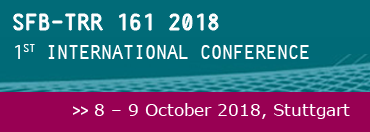The SFB-TRR 161 organizes various events to promote research activities and to inform about current developments in research and education in the field of Visual Computing, both at a national and an international level.
Jan 19th, 2026, 4 pm - 6 pm
University of Konstanz
Lecture | Title tba
Held by:
Jakub Lokoč, Charles University, Prague, Czech Republic
Abstract:
tba
Bio:
tba
Location:
University of Konstanz, Room ZT 702.
University of Stuttgart: The lecture will be transmitted to VISUS, room 00.012
The talks are available via Zoom.
Meeting ID:
Passcode:
For participants via Zoom: The transmission will kindly be managed by Dimitar Garkov. He will be on site and monitor/manage the Zoom-Session incl. Q&A during and after the talk as well. Please do not hesitate to get in touch with Dimitar in case of questions or problems regarding the transmission/your online participation: dimitar.garkov@uni-konstanz.de
Jan 26th, 2026, 4 pm - 6 pm
LMU Munich
Lecture | Title tba
Held by:
Joanna Bergström, University of Copenhagen, Denmark
Abstract:
tba
Bio:
tba
Location:
tba
Feb 2nd, 2026, 4 pm - 6 pm
University of Stuttgart
Lecture | Title tba
Held by:
Michael Doggett, Lund University, Sweden
Abstract:
tba
Bio:
tba
Location:
tba
Mar 12th - 13st, 2026
University of Konstanz, Room ZT 1204 (Data Theatre)
Hackathon DR4ET
Organized by:
Patrick Paetzold, Michael Stroh, Ying Zhang
Proposal Submission:
Given the success of past Hackathons, we encourage you to submit a proposal to recruit talented individuals for your project at this year’s event. Please email your PDF to Ying Zhang.
Proposal Deadline: Dec 1st, 2025.
Once we've collected all the proposals and given the authors their feedback, you'll be asked to vote on a topic to get involved.
Location:
University of Konstanz, Room ZT 1204 (Data Theatre)
Jun 16th - 17th, 2026, full days
Internal Status Seminar of the SFB-TRR 161
News and Press
BOGY in der Forschung?
Du möchtest schon während der Schulzeit die Welt der Forschung kennenlernen? Du möchtest dich über die Studiengänge an unseren Transregio Partnern informieren? Du programmierst gerne oder interessierst dich für Informatik und Computergrafik?
Ein BOGY im SFB-TRR 161 gibt dir die Chance, dich mit unseren Forschern auszutauschen und in die Arbeitswelt der Wissenschaft einzutauchen.
FOR SCIENTISTS
Projects
People
Publications
Graduate School
Equal Opportunity
FOR PUPILS
PRESS AND MEDIA
© SFB-TRR 161 | Quantitative Methods for Visual Computing | 2019.







